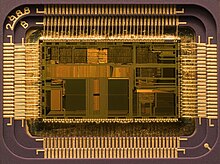Microprocessor
A microprocessor is an electronic component that is used by a computer to do its work. It is a central processing unit on a single integrated circuit chip containing millions of very small components including transistors, resistors, and diodes that work together. Some microprocessors in the 20th century required several chips. Microprocessors help to do everything from controlling elevators to searching the Web. Everything a computer does is described by instructions of computer programs, and microprocessors carry out these instructions many millions of times a second. [1]


Microprocessors were invented in the 1970s for use in embedded systems. The majority are still used that way, in such things as mobile phones, cars, military weapons, and home appliances. Some microprocessors are microcontrollers, so small and inexpensive that they are used to control very simple products like flashlights and greeting cards that play music when opened. A few especially powerful microprocessors are used in personal computers.
TSMC, Intel, Qualcomm, and Samsung are considered the biggest chipmakers.[2]
Microprocessor operation
changeLike other central processing units, microprocessors use three steps commonly called Fetch, Decode, and Execute. In the Fetch step, an instruction is copied from the computer memory into the microprocessor. In the Decode step, the microprocessor figures out what operation the instruction is meant to do. In the Execute step, this operation is performed. Different computers can have different instruction sets.
Facts and figures
change- Transistors in a microprocessor can be less than one micrometer wide—one millionth of a meter. By comparison, a single hair can be over 100 micrometers wide.
- The transistors are mostly MOSFETs
- Modern microprocessors run billions of instructions every second.
- Microprocessors are made from silicon, quartz, metals, and other chemicals.
- From start to finish, it takes about 2 months to make a microprocessor.
- Microprocessors are classified by the size of their data bus or address bus. They are also grouped into CISC and RISC types.
Brief history
change- 1823 Baron Jöns Jacob Berzelius discovers silicon (Si), which today is the basic component of electronics.
- 1903 Nikola Tesla patents electrical logic circuits called "gates" or "switches".
- 1947 John Bardeen, Walter Brattain, and William Shockley invent the first transistor at the Bell Laboratories on December 23, 1947.
- 1956 John Bardeen, Walter Brattain, and William Shockley are awarded the Nobel Prize in physics for their work on the transistor.
- 1958 The first integrated circuits are developed by Robert Noyce and Jack Kilby.
- 1960 IBM develops the first automatic mass-production facility for transistors in New York.
- 1971 Intel 4004, first commercially available microprocessor Archived 2020-11-12 at the Wayback Machine.
References
change- ↑ Marshall Brain (2015). "How Microprocessors Work". InfoSpaceLLC. Retrieved 27 May 2015.
- ↑ https://www.kyivpost.com/analysis/32614. Retrieved 2024-05-16